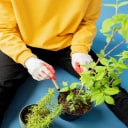Pomegranate – Outdoor Bonsai Tree
The pomegranate tree (Punica granatum) is a deciduous shrub or small tree that typically grows to a height of 5-10 meters (16-33 feet). It is native to the region extending from modern-day Iran to northern India and has been cultivated throughout the Mediterranean region and other parts of the world.
Description
- Leaves: The leaves are glossy, narrow, and oblong, growing in opposite pairs or clusters.
- Flowers: The flowers are bright red and typically bloom from late spring to early summer. They are tubular with five to seven petals and can grow singly or in clusters.
- Fruit: The pomegranate fruit is roughly spherical and has a tough, leathery rind that ranges in color from yellow-orange to deep red. Inside, the fruit is filled with hundreds of edible seeds, each surrounded by a juicy, red aril.
- Seeds: The seeds are small, crunchy, and embedded within the white, spongy pith inside the fruit.
Cultivation
- Climate: Pomegranates thrive in hot, dry climates and can tolerate drought conditions. They prefer full sunlight and well-drained soil.
- Watering: While pomegranate trees are drought-tolerant, they produce better fruit with regular watering, especially during dry periods.
- Pruning: Pruning is essential to shape the tree, remove dead or diseased wood, and improve air circulation. It also helps to maintain the size and health of the tree.
Uses
- Culinary: Pomegranate seeds and juice are used in a variety of culinary applications, including salads, sauces, desserts, and beverages. The juice is often enjoyed fresh or used to make grenadine syrup.
- Medicinal: Pomegranates are known for their high antioxidant content and potential health benefits, including anti-inflammatory properties and potential heart health benefits.
- Ornamental: The tree is also grown for its attractive appearance, with its vibrant flowers and unique fruit adding aesthetic value to gardens and landscapes.
Care Tips
- Soil: Plant in well-drained soil with a pH level between 5.5 and 7.0.
- Fertilization: Fertilize the tree in early spring before new growth starts and again in late summer.
- Pests/Diseases: Watch out for common pests such as aphids, whiteflies, and pomegranate fruit borers. Fungal diseases like leaf spot and fruit rot can also affect the tree.
With proper care, a pomegranate tree can be a beautiful and productive addition to any garden.








Reviews
Clear filtersThere are no reviews yet.